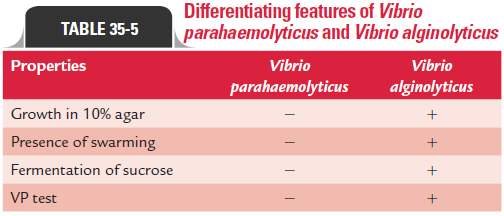Chapter: Microbiology and Immunology: Bacteriology: Vibrio,Aeromonas,and Plesiomonas
Halophilic Vibrios
Halophilic Vibrios
Vibrios that require a higher concentration of sodium chloride are known as halophilic vibrios. They are natural inhabitants of sea water and marine life. V. parahaemolyticus, Vibrio alginolyticus, and V. vulnificus are three important halophilic vibrios species known to cause infection in humans.
Vibrio parahaemolyticus
V. parahaemolyticus is now recognized as an important causeof seafood-associated gastroenteritis throughout the world.
V. parahaemolyticus is a curved Gram-negative bacillus thatresembles V. cholerae. However, it differs from V. cholerae by hav-ing a capsule showing bipolar staining and pleomorphism. It shows pleomorphism especially in cold cultures or when grown on 3% salt agar. Like other vibrios, it has polar flagella when grown in liquid culture, but shows peritrichous flagella when grown on solid media.
It has simple nutritional requirement, but requires salt for growth. The organism fails to grow in the medium in the absence of sodium chloride. It can grow well in salt con-centration up to 8% and at an optimum salt concentration of 2–4%.
On MacConkey agar, it produces colorless nonlactose-fermenting colonies; on blood agar, it forms beta-hemolytic colonies. The colo-nies on TCBS agar are nonsucrose-fermenting green colonies with an opaque and raised center and translucent periphery.
V. parahaemolyticus is oxidase, catalase, indole, and citratepositive. It reduces nitrates to nitrites. It is a fermenter ferments glucose, mannose, maltose, mannitol, and arabinose with pro-duction of acid only. It does not ferment sucrose, lactose, and salicin. It decarboxylates lysine and ornithine but not arginine. It is VP positive.
V. parahaemolyticus is a heat-labile bacterium, readilydestroyed at 60°C in 15 minutes. It is susceptible to drying, dis-tilled water, and vinegar in which it dies within a few minutes. The organism, however, can remain viable on freezing and refrigeration.
V. parahaemolyticus contains three antigens: somatic O anti-gens, flagellar H antigens, and capsular K antigen. Serotyping is based on O and K antigen.
· Thermostable direct hemolysin is the key virulence factor of V. parahaemolyticus. This virulence factor is found only in strains that are pathogenic to human beings.
· Strains isolated from humans possess this toxin, hence are pathogenic, while strains isolated from environment source, such as water, crabs, oysters, or fish do not possess this ther-mostable toxin, hence are nonpathogenic.
V. parahaemolyticus is widely distributed in estuary andmarine environments. Seafood, such as fish, crabs, or oysters, is the main source and reservoir of infection. The infection is acquired on consumption of contaminated seafood.
V. parahaemolyticus in humans causes gastroenteritis. Theseverity of the condition can vary from mild self-limited diar-rhea to an acute illness. After an incubation period of 5–72 hours, the patients with gastroenteritis manifest as eosino-philic watery diarrhea. The condition is associated with nausea, vomiting, abdominal pain, and low-grade fever, which may be present for 3 days. Stool usually does not contain any blood or mucus, but contains cellular exudates. The patient usually recovers within 3 days.
V. parahaemolyticus also causes extraintestinal infections,such as wound infections and ear and eye infections in indi-viduals exposed to contaminated sea water.
V. parahaemolyticus, although widely found in sea fish insome parts of India, is relatively less common in human infections.
Vibrio alginolyticus
V. alginolyticus is another halophilic vibrio. It shows a high salttolerance and can grow even in the presence of 10% sodium chloride. On TCBS agar, it forms large yellow sucrose-ferment-ing colonies. It shows swarming on the surface of nonselective medium, such as blood agar. V. alginolyticus is widely distrib-uted in sea water and seafood. V. alginolyticus is associated with infections of superficial wounds exposed to contaminated sea water. It also has been associated with infections of the gastrointestinal tract, ear, and eye. Differentiating features of V. parahaemolyticus and V. alginolyticus are summarized in Table 35-5.

Vibrio vulnificus
V. vulnificus is a halophilic vibrio, formerly known as L vib-rio, or Benekea vulnificus. Like V. parahaemolyticus, V. vulnificus is a Gram-negative bacillus and facultative anaerobe that requires salt for growth. It also produces green nonsucrose-fermenting colonies on TCBS medium. It differs from V. parahaemolyti-cus and other Vibrio species by its ability to ferment lactose.Relatively, V. vulnificus is a more virulent bacterium than V.parahaemolyticus. Presence of capsule and production of hydro-lytic enzymes, such as cytolysins, proteases, and collagenases are responsible for virulence of the bacteria. These organisms are also resistant to complement- and antibody-mediated lysis.
V. vulnificus is a natural inhabitant of sea water. V. vulnificus infections are usually food-borne diseases and are largely asso-ciated with (a) ingestion of raw or undercooked seafood and (b) exposure of wound to contaminated sea water.
V. vulnificus infection in humans produces two types ofillness: (a) wound infection and (b) gastroenteritis rapidly progressing to septicemia. Wound infection caused by contam-inated sea water has a short incubation period of 3–24 hours. These wounds are usually present on the fingers, palms, or soles of the feet. The condition rapidly progresses to necrosis, gan-grene, or necrotizing fasciitis. The wound infection in patients with cirrhosis or malignancies may progress very rapidly with development of hemorrhagic bullae and extensive soft tissue necrosis.
Gastroenteritis rapidly progressing to septicemia occurs following the consumption of raw seafood on exposure of broken skin to warm sea water after a short incubation period of 12–48 hours. The bacteria on ingestion penetrate the intestinal mucosa, but do not cause any gastrointesti-nal manifestations and enter blood stream rapidly, causing septicemia. The condition manifests as multiple hemor-rhagic bullae and extensive ecchymosis distributed mainly on the lower extremities. Patients frequently become hypo-tensive and develop oliguria and noncardiogenic pulmonary edema. This condition is associated with mortality rate as high as 50%.
Diagnosis of the condition is made by isolation of the bacte-ria from wounds and blood.
Since V. vulnificus produces life-threatening illness, imme-diate and prompt treatment with antibiotics is essential. Tetracyclines or aminoglycosides are the antibiotics of choice for treatment of the condition. The condition is prevented by avoidance of raw and undercooked seafood.
Related Topics